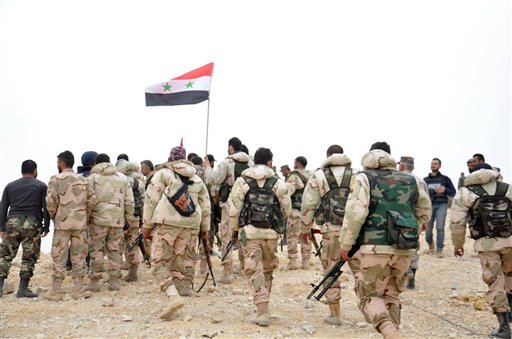
In this photo released by the Syrian official news agency SANA, Syrian soldiers gather around a Syrian national flag in Palmyra, Syria, Sunday, March 27, 2016. Syrian state media and an opposition monitoring group say government forces backed by Russian airstrikes have driven Islamic State fighters from the historic central town of Palmyra, held by the extremists since May. SANA via AP
DAMASCUS, Syria — Syrian government forces backed by Russian airstrikes drove Islamic State fighters from Palmyra on Sunday, ending the group’s reign of terror over a town whose famed 2,000-year-old ruins once drew tens of thousands of visitors each year.
Government forces had been on the offensive for nearly three weeks to try to retake the central town, known among Syrians as the “Bride of the Desert,” which fell to the extremists last May. Their advance marks the latest in a series of setbacks for IS, which has come under mounting pressure on several fronts in Iraq and Syria in recent months.
Gen. Ali Mayhoub announced on state TV that that the fall of Palmyra “directs a fatal blow to the ISIL, undermines the morale of its mercenaries, and ushers in the start of its defeat and retreat.” He said it lays the ground for further advances toward Raqqa, the IS group’s de facto capital, and Deir el-Zour, an eastern city it largely controls.
Troops in Palmyra are now dismantling explosive booby traps planted by IS, the station reported. State TV and a Britain-based monitoring group later reported that troops captured a military base to the east.
The advance marks a strategic and symbolic victory for the government, which has sought to portray itself as a bulwark against terrorism. The town was an important juncture on an IS supply line connecting its territory in central and northern Syria to the Anbar province in Iraq, where the group also holds territory.
IS drove government forces from Palmyra in a matter of days last May and later demolished some of the best-known monuments in its UNESCO world heritage site, including two large temples dating back more than 1,800 years and a Roman triumphal archway.
The extremists have destroyed a number of historical sites across their self-declared caliphate, viewing such ruins as monuments to idolatry.
IS also demolished Palmyra’s infamous Tadmur prison, where thousands of government opponents were reportedly tortured.
Syrian state TV hailed the government’s advance, and a local reporter spoke live from inside Palmyra, showing troops in the center of the town. Some of the nearby buildings had been reduced to rubble.
Syrian Culture Minister Issam Khalil hailed the recapture of Palmyra as a “victory for humanity and right over all projects of darkness.” Maamoun Abdulkarim, director of the museums and antiquities department in Damascus, said Palmyra’s Great Colonnade had suffered only minor damage. “We will rebuild what you have destroyed,” he said, addressing IS.
The Syrian opposition, which blames the government for the country’s devastating civil war and the rise of IS, rejected that narrative.
“The government wants through this operation to win the favor of Western nations by fighting against terrorism, while obscuring its responsibility as providing the reasons for the spread of terror,” said Khaled Nasser, a member of the opposition coalition that has been negotiating with the government in Geneva.
The Britain-based Syrian Observatory for Human Rights, which monitors the conflict through local activists, confirmed IS had lost the town. Observatory chief Rami Abdurrahman said three weeks of fighting killed more than 400 IS fighters, as well as 180 troops and pro-government militiamen.
Residents told The Associated Press that IS evacuated all of Palmyra’s civilians to other territories under its control before government forces entered the city.
Government forces have advanced on a number of fronts in recent months, aided by a Russian air campaign. Moscow announced earlier this month that it would begin drawing down its forces, but said it will continue to target IS and other extremist groups.
Russian jets carried out 40 air sorties near Palmyra in a 24-hour period, hitting 158 targets and killing more than 100 militants, Russia’s defense minister said Saturday.
The government has also benefited from a U.S. and Russian-brokered cease-fire that has sharply reduced violence across the country since it took effect last month. IS and the al-Qaida-affiliated Nusra Front are excluded from the agreement. The truce is intended to support peace talks underway in Geneva that were adjourned last week.
Syria’s conflict began a little more than five years ago with mostly peaceful protests against the Assad family’s four-decade rule. A fierce government crackdown and the rise of an insurgency plunged the country into a full-blown civil war that has killed more than 250,000 people.